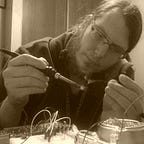The Nuts and Bolts of Thread Standards
Have you ever wondered why your screws are the way they are? What does 4–40 really mean? Why are there different screws used all over the world? Wouldn’t it be simpler if we just all used the same screws for everything?
Engineers all over the world have been trying to agree on a standard for machine screws since the mid-19th century, with the US, UK, France, and Germany leading the way. You may already notice the problem - France and Germany are solidly metric, whereas the UK and the US use the imperial system. So we need two different standards and ways to convert between the two.
It’s estimated that screws and fasteners have been around since 300 BC, and possibly much earlier. Fasteners were typically quite large and used for tasks like raising water buckets from a water source. It wasn’t until the mid-18th century that a technological innovation allowed much tighter control over creating threads — the screw drive on a lathe. This allows a lathe head to move a defined amount per each rotation of the chuck, creating even, regular threads. Without this innovation, screws could not have been miniaturized to the extent that they are today!
Even with the innovation of the screw drive, tighter tolerances and inter-compatibility were needed. The long, slow march towards a standards body like the International Standards Organizations (ISO) or the Deutsches Institut für Normungor (DIN) began in the late 19th century, almost 150 years after the development of the screw drive.
Clearly, in that much time, a lot of diverging standards and practices would be developed, and each country wanted to have their own style of fastener. In 1898, at a conference in Zurich, the industrial powers of Western Europe came together to try to hammer out a standard for fasteners. The need for interchangeability was widely recognized, and the United States had previously come up with their standard, based on a patent by William Sellers. Sellers’ fastener had become the de facto standard in American manufacturing, but every country in Europe had their own screws and standards. It became clear a that solution was necessary. Out of the Zurich Congress came the basis for today’s ISO standard metric thread sizes. It wasn’t an easy fix — France and Japan, among other nations, insisted on using their own modified versions of the standard.
It wasn’t until the late 1940s after the aftermath of the Second World War had diminished that international standards started to be enforced. ISO was created in 1947, and in 1949 the American United Thread System (UTS) was developed to standardize imperial thread sizes. Guess what the ISO standard #1 is? The standard temperature, 20° Celsius, for measuring the geometries of things like fasteners!
Efforts continued to try and find ways to have the two systems interoperate, but as the metric system became more and more widespread and it was clear that the US was the last holdout of the imperial system, efforts shifted to making the metric threads the de facto world standard.
So, what does 4–40 mean? I often use 4–40 screws, as I find they are readily available and the perfect size for PCB stand-offs. Down the rabbit hole we go! The 4 means UTS standard size number 4, which is a major diameter 0.112 inches, or 2.8448mm. Still with me? The 40 means 40 threads per inch, which represents a pitch size of 0.025 inches or 0.635mm.
It still seems like an awful mess to me. What’s an M4 machine screw? 4mm diameter, 0.5mm pitch. If you look at the metric and imperial standard thread charts side-by-side, well — I’ll let you choose which seems more sensible.
